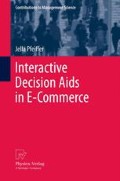Abstract
In this chapter, we present a new approach for the design of choice task experiments that analyze the final respondent’s choice but not the decision process.1 The approach creates choice tasks with a one-to-one correspondence between decision strategies and the observed choices. Thus, a decision strategy used is unambiguously deduced from an observed choice. Furthermore, the approach systematically manipulates the characteristics of choice tasks and takes into account measurement errors concerning the preferences of the decision makers. We use this approach to generate respondent-specific choice tasks with either low or high complexity and study their influence on the use of compensatory and non-compensatory decision strategies. We provide results for the same three measurements of context-based complexity, namely the attribute range, the attractiveness difference, and the correlation of attribute vectors, which we considered in the previous study in Chap. 3. Furthermore, we study two measurements of task-based complexity, namely the number of alternatives and the number of attributes. We find that an increase in context-based complexity and number of alternatives lead to an increased use of non-compensatory strategies and a decreased use of compensatory decision strategies. In contrast, the number of attributes does not influence strategy usage. Furthermore, we observe interaction effects between the attribute range and the correlation of attribute vectors. The proposed approach does not rely on particular decision strategies or hypotheses to be tested and is immediately applicable to a wider range of decision environments. It contributes to research attempts that create designs that maximally discriminate between different models (see Sect. 2.3 and Myung and Pitt 2009).
Access this chapter
Tax calculation will be finalised at checkout
Purchases are for personal use only
Notes
- 1.
The experimental study was conducted in cooperation with Dejan Duzevik (Icosystem Corporation, consulting agency, USA) and Koichi Yamamoto (Dentsu Incorporated, advertising agency, Japan).
- 2.
Dellaert et al. (1999) define choice consistency as “the variance of the random error component in the consumer utility function: the smaller this variance, the higher choice consistency” [p. 1]. Thus, the higher the consistency is, the better WADD explains the choice.
- 3.
We will either optimize objectives 1,2,4,5 or objectives 1,3,4,5. Thus, in half of the runs f 2 measures the attribute range and in the other half it measures the attractiveness difference.
- 4.
The same holds for AD in case we are manipulating AD instead of AR.
- 5.
Since we did not find any significant interactions for AC and AD, we refrain from reporting equivalent numbers for this combination.
Author information
Authors and Affiliations
Corresponding author
Rights and permissions
Copyright information
© 2012 Springer-Verlag Berlin Heidelberg
About this chapter
Cite this chapter
Pfeiffer, J. (2012). The Influence of Task and Context-Based Complexity on the Final Choice. In: Interactive Decision Aids in E-Commerce. Contributions to Management Science. Physica-Verlag HD. https://doi.org/10.1007/978-3-7908-2769-9_4
Download citation
DOI: https://doi.org/10.1007/978-3-7908-2769-9_4
Published:
Publisher Name: Physica-Verlag HD
Print ISBN: 978-3-7908-2768-2
Online ISBN: 978-3-7908-2769-9
eBook Packages: Computer ScienceComputer Science (R0)

